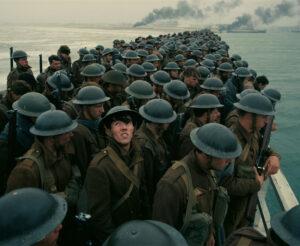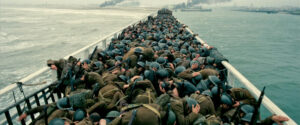Dunkirk (2017) review
Dir. Christopher Nolan
By: Steve Pulaski
Rating: ★★★
Dunkirk is a cold-blooded, white-knuckled affirmation of the abilities possessed by the theatrical moviegoing experience. After exhausting the Batman franchise and character in such a way that will more than likely make every film about The Caped Crusader pale in comparison, in addition to giving us a rousing display of intergalactic travel via an emotional epic, director Christopher Nolan brings us Dunkirk, an often harrowing, well-made motion picture. When you’re watching the film in a theater, it’s almost unthinkable, and a bit bone-chilling, to think some people will be watching this same film on their laptops or smartphones not only this weekend, but in the years to come.
Forewarning: I’ll be starting many sentences with the phrase “when you’re watching Dunkirk…” almost too often due to the film’s nature of being very experience-based. A person watching this on the average movie-screen (known as Digital Cinema Package – DCP) will have a vastly different experience than someone like myself, who watched the film on a gigantic IMAX screen. And let’s not forget the privileged few who will venture out to one of the couple dozen theaters in North America of the 3,500 where Dunkirk is playing to witness the film in IMAX 70mm, the format Nolan says is the best of all. Their experience might render them part of an exclusive club where only they will know how truly good Dunkirk is.
Structured like a non-linear triptych, Nolan’s latest looks at the Allied evacuation of 400,000 troops at Dunkirk during World War II through three perspectives: land, sea, and air. Most men are French and British troops dodging gunfire and aerial attacks while essentially being starved out in the coastal town of Dunkirk, France. A handful of characters are discerned through the mess of brown and black artillery and hard-hats, one of whom being the young Tommy (Fionn Whitehead), a British troop who waits for rescue on the vast emptiness of a beach. Meanwhile, a father (Mark Rylance), his son (Tom Glynn-Carney), and his son’s friend (Barry Keoghan) spend the entire day watching the madness unfold from their small boat as they make an effort to cross the English Channel in pursuit of France with a wounded soldier in tow. And, finally, up above we witness a couple fighter pilots (Tom Hardy) take out enemy planes while trying to clear skies and make aerial rescue even possible for these thousands of young men.
Nolan, who wrote the film by himself, his first solo-script since Inception seven years ago, discards much of the dialog we expect from war films. Most audible phrases are exclamatory or impulsive remarks from the mouths of the soldiers. Rylance is really the only person in the film that gets any kind of character development or dramatic edge, as most of the characters, including Tommy, work with what little spoken dialog they have. This strips Dunkirk down to the very basics of a war film, starting and concluding with survival, one’s most instinctive reaction to any dangerous setting.
By discarding dialog, Nolan also gives us a film that shows us the situational and spatial difficulties with which soldiers must work. We see the perspective of Hardy’s character in a fighter jet, confined in a space about as big as what an office-chair allows, equipped with desperately little sense of space and distance when enemies begin to engage. The aerial combat scenes are what I found to be the most harrowing of all. They involve so little time for the characters to react, such improbable odds and uncomfortable conditions for them to work, and frustratingly limited time for any kind of elaborate plan to be executed.
The improbability of Dunkirk hits you even when you’re watching all of the action unfold. The film is not particularly bloody, but the sheer loudness and gravity of screeching planes, deafening gunfire, and eardrum-shattering explosives all work to paint a film that doesn’t have to disturb the squeamish. When you’re watching Dunkirk on a screen as large as the one an IMAX experience allows, your entire field of vision is arrested by the film’s gray and blue cinematography (courtesy of Hoyte van Hoytema, who also worked on Spectre), and the enhanced sound makes all of the aforementioned occurrences in the film an immersive moviegoing experience.
I say “moviegoing experience” because I find Dunkirk a lot more of an experience and a technical achievement than a truly great film. It’s far more along the lines of something like Gravity and Run Lola Run as opposed to Saving Private Ryan. Shot in 65mm, the film is a crystal clear, aesthetic marvel with a grand amount of visuals packed into such a short runtime, but I wonder if the same people who are claiming that Dunkirk is such a revolutionary movie would’ve said the same had they watched it on their own television, or if the film had been released sans IMAX or other specialty formats.
This is, again, because Dunkirk is an experience, and when it’s all said and done, the way you watched the film is about as important as whether or not you did see the film. There are no characters on which to fall back. There is no personalized drama or even personalized accounts of the individuals involved in the evacuation. Most of the previously noted characters get a handful of dialog and even less to exchange with one another, and when the film concludes, you reflect on the thrill-ride that was the film rather than the connection you had to any soul in the movie whatsoever. Some might be able to get past that, maybe those who have served their country; I cannot as someone who craves characters in the films I watch.
In a way, this is both a criticism and a simple comment about the film. Nolan’s intention is obviously to show the plight of a large group of men, all stuck in similar situations, dressed indiscernible from one another, and faced with insurmountable odds in regards to their common goal of getting home. Dunkirk could absolutely be considered minimalist, but remove its debatably landmark technical attributes, and I’d argue it would hardly be considered memorable.

Certain shots of the film carry a lot of weight and show how mathematical and geometric Nolan is with framing and precision. There’s a shot of a soldier on a boat as him and his acquaintance’s father look onward at the black smoke and flames at Dunkirk, as seen through the windshield of the boat, that’s so precise despite the undoubtedly rough filming conditions. There’s a serene shot of a pilot standing before a plane engulfed in flames, and as we see the man with his back towards the camera, he almost fades into becoming a silhouette figure. There’s a terrific long-shot that captures the sameness of the soldiers from a birds-eye perspective as a sea of helmets, and there are a slew of very well-filmed and precisely edited (by Lee Smith, Nolan’s go-to editor since Batman Begins) scenes in the sky and on the rocky waters that loan themselves to being picturesque.
But all of these shots would’ve been that much more impacting had we known even a little more about the characters we are witnessing. Instead, it’s back to the Lone Survivor paradox, where the ultimate goal is to keep the memory of these brave, selfless individuals alive, yet how can we if we hardly are informed of their first names until the end-credits?
The film runs at a lean 107 minutes, which is absolutely perfect given what Dunkirk is trying to accomplish. Any longer would’ve made perfunctory backstory about Nazi-occupied Germany and America’s eventual involved in World War II a subplot we simply didn’t need, and any shorter would’ve felt even more slight. Dunkirk is a mean, muscled war-movie, but it’s too dependent on aesthetics and how those aesthetics are viewed to be considered much else.
NOTE: My audio review/discussion of Dunkirk from my radio show Sleepless with Steve:
NOTE II: As of this writing, Dunkirk is available to rent on multiple streaming platforms.
My review of Tenet (2020)
My review of Oppenheimer (2023)
Starring: Fionn Whitehead, Mark Rylance, Tom Glynn-Carney, Tom Hardy, Harry Styles, Jack Lowden, and Cillian Murphy. Directed by: Christopher Nolan.
About Steve Pulaski
Steve Pulaski has been reviewing movies since 2009 for a barrage of different outlets. He graduated North Central College in 2018 and currently works as an on-air radio personality. He also hosts a weekly movie podcast called "Sleepless with Steve," dedicated to film and the film industry, on his YouTube channel. In addition to writing, he's a die-hard Chicago Bears fan and has two cats, appropriately named Siskel and Ebert!


